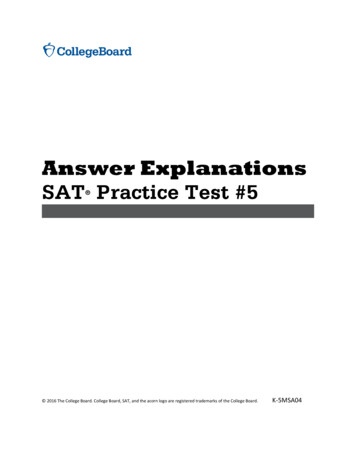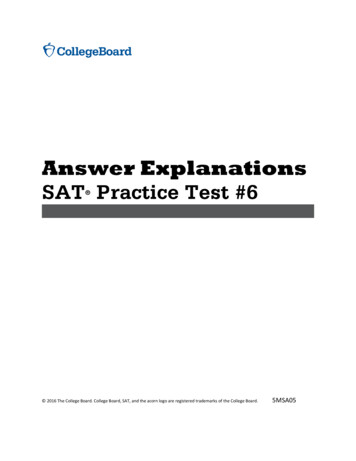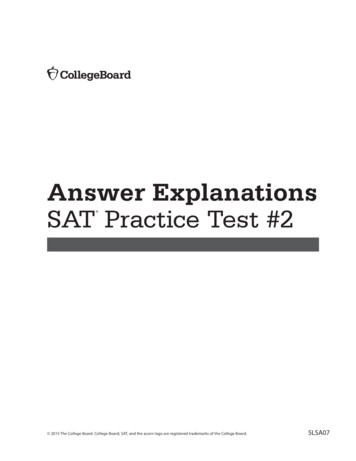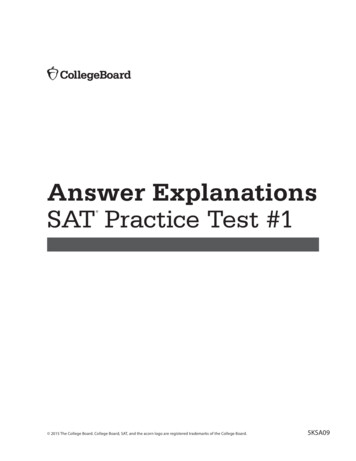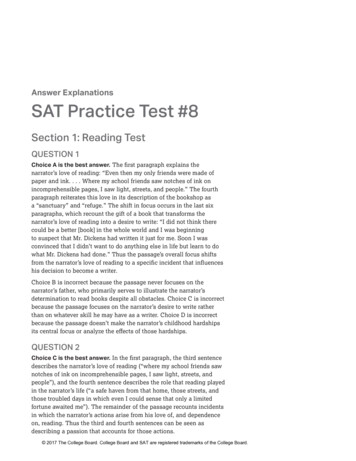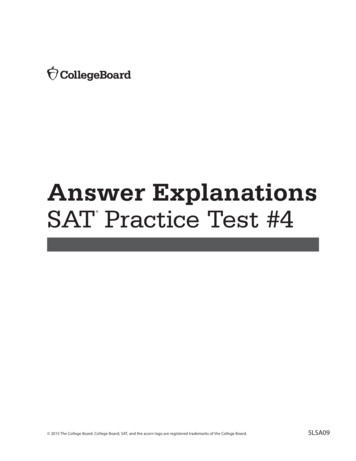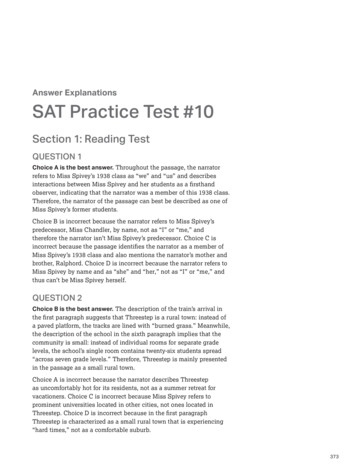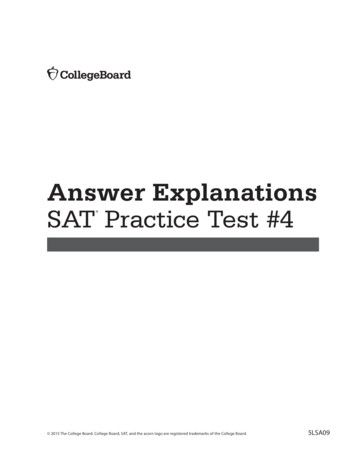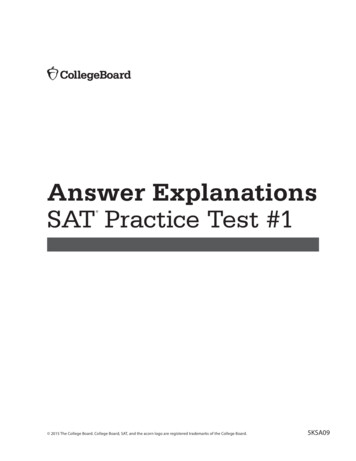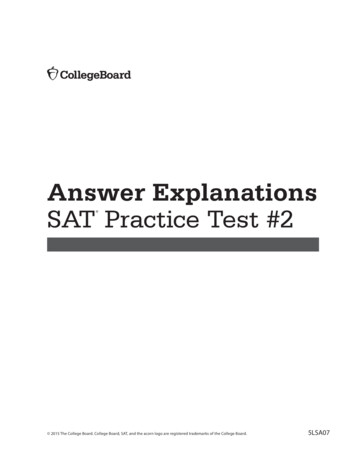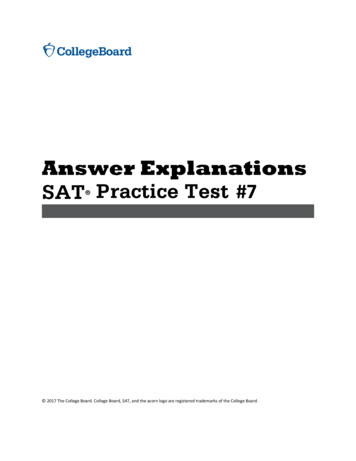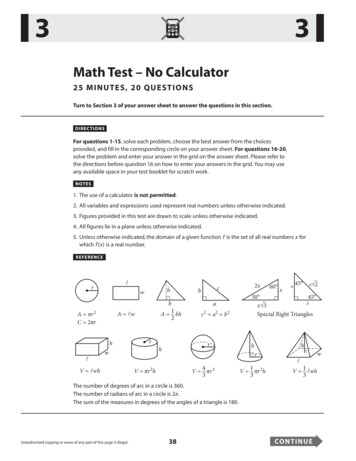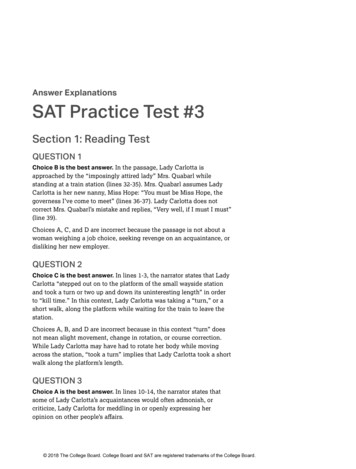
Transcription
Answer ExplanationsSAT Practice Test #3Section 1: Reading TestQUESTION 1Choice B is the best answer. In the passage, Lady Carlotta isapproached by the “imposingly attired lady” Mrs. Quabarl whilestanding at a train station (lines 32-35). Mrs. Quabarl assumes LadyCarlotta is her new nanny, Miss Hope: “You must be Miss Hope, thegoverness I’ve come to meet” (lines 36-37). Lady Carlotta does notcorrect Mrs. Quabarl’s mistake and replies, “Very well, if I must I must”(line 39).Choices A, C, and D are incorrect because the passage is not about awoman weighing a job choice, seeking revenge on an acquaintance, ordisliking her new employer.QUESTION 2Choice C is the best answer. In lines 1-3, the narrator states that LadyCarlotta “stepped out on to the platform of the small wayside stationand took a turn or two up and down its uninteresting length” in orderto “kill time.” In this context, Lady Carlotta was taking a “turn,” or ashort walk, along the platform while waiting for the train to leave thestation.Choices A, B, and D are incorrect because in this context “turn” doesnot mean slight movement, change in rotation, or course correction.While Lady Carlotta may have had to rotate her body while movingacross the station, “took a turn” implies that Lady Carlotta took a shortwalk along the platform’s length.QUESTION 3Choice A is the best answer. In lines 10-14, the narrator states thatsome of Lady Carlotta’s acquaintances would often admonish, orcriticize, Lady Carlotta for meddling in or openly expressing herRSLQLRQ RQ RWKHU SHRSOHŞV DƬDLUV 2018 The College Board. College Board and SAT are registered trademarks of the College Board.
Choices B, C, and D are incorrect because the narrator does notsuggest that other people viewed Lady Carlotta as tactful, ambitious,or unfriendly.QUESTION 4Choice A is the best answer. In lines 10-14, the narrator states thatpeople often criticized Lady Carlotta and suggested that she notLQWHUIHUH LQ RWKHU SHRSOHŞV DƬDLUV ZKLFK ZHUH ŠQRQH RI KHU EXVLQHVV š The fact that people often were critical of Lady Carlotta’s behaviorprovides evidence that Lady Carlotta was outspoken.Choices B, C, and D do not provide the best evidence that LadyCarlotta was outspoken. Choices B, C, and D mention Lady Carlotta,but do not specify how others view her.QUESTION 5Choice C is the best answer. Lines 4-10 establish that Lady Carlottaintervened on the part of a struggling horse, the kind of behavior forwhich, lines 10-14 indicate, she received “plentiful admonition” from“certain of her acquaintances,” who believed that she should mind herown business. Lines 14-22 indicate that Lady Carlotta had “only once . . .put the doctrine of non-interference into practice,” and that was when“one of its most eloquent exponents” had been “besieged for nearlythree hours in a small and extremely uncomfortable may-tree by anangry boar-pig” while Lady Carlotta blithely ignored the other woman’shypocritical pleas for interference. This incident provides insight intoLady Carlotta’s character and also evokes humor through language choice(e.g., the droll understatement of “it is to be feared that [Lady Carlotta] lostthe friendship of the ultimately rescued lady”; lines 22-23) and the sensethat, narratively speaking, justice has been served.Choice A is incorrect because nothing about the incident suggestsdeception on Lady Carlotta’s part. Choice B is incorrect becausethere is nothing subtle about Lady Carlotta leaving another womanstuck in a tree for nearly three hours. Moreover, the passage does notsuggest that this was an act of cruelty on Lady Carlotta’s part; rather,WKH SDVVDJH VXJJHVWV WKDW /DG\ &DUORWWD ZDV MXVWLƮHG LQ JLYLQJ WKH woman stuck in a tree exactly what the woman had so often asked for:noninterference. Choice D is incorrect because the passage indicatesthat Lady Carlotta was acting consistently with her beliefs and onlyinvoked the doctrine to teach a hypocritical person a lesson.QUESTION 6Choice A is the best answer. The narrator explains that Mrs. Quabarltold Lady Carlotta about the “nature of the charge” when she gave LadyCarlotta details about the Quabarl children (line 53-61). Since LadyCarlotta is pretending to be a governess, the term “charge” refers to herresponsibilities, or job duties, when caring for the Quabarl children.
ANSWER EXPLANATIONS̝ ̝6 7 3UDFWLFH 7HVW Choices B, C, and D are incorrect because in this context “charge”does not mean attack, fee, or expense.QUESTION 7Choice A is the best answer. Lady Carlotta learns about Mrs. Quabarl’schildren Claude, Wilfrid, and Irene (lines 53-58). The narrator thendescribes Mrs. Quabarl’s child Viola as “something or other else of amould equally commonplace among children of that class and type inthe twentieth century” (lines 58-61). This statement about Viola impliesthat all of the Quabarl children have skills typical, or “of a mouldequally commonplace,” to other peers in their social class.Choices B, C, and D are incorrect because the narrator does notindicate that all of the Quabarl children are unusually creative andintelligent, hostile to the idea of having a governess, or more educatedthan their peers.QUESTION 8Choice B is the best answer. In lines 62-69, Mrs. Quabarl explainsto Lady Carlotta that she wants her children to actively participate intheir education, and that Lady Carlotta should not create lessons thatUHTXLUH KHU FKLOGUHQ WR VLPSO\ PHPRUL]H KLVWRULFDO ƮJXUHV DQG GDWHV Mrs. Quabarl emphasizes an education centered on active engagementwhen she states that her children should “not only be TAUGHT . . . butINTERESTED in what they learn.”Choices A, C, and D are incorrect because the narrator does notsuggest that Mrs. Quabarl favors an education that emphasizestraditional values, artistic experimentation, or factual retention.QUESTION 9Choice B is the best answer. In lines 77-82, the narrator describes0UV 4XDEDUO DV DSSHDULQJ ŠPDJQLƮFHQW DQG DXWRFUDWLF š RU RXWZDUGO\ domineering, but easily “cowed and apologetic” when someoneFKDOOHQJHV RU GHƮHV KHU DXWKRULW\ Choices A, C, and D are incorrect because the narrator does notGHVFULEH 0UV 4XDEDUO DV VHOƮVK ELWWHU RU IUHTXHQWO\ LPSUXGHQW QUESTION 10Choice D is the best answer. In lines 77-82, the narrator providesevidence that Mrs. Quabarl appears imposing, or autocratic, but isHDVLO\ GHƮHG RU RSSRVHG Š6KH ZDV RQH RI WKRVH LPSHUIHFWO\ VHOI DVVXUHG LQGLYLGXDOV ZKR DUH PDJQLƮFHQW DQG DXWRFUDWLF DV ORQJ DV WKH\ are not seriously opposed. The least show of unexpected resistancegoes a long way towards rendering them cowed and apologetic.”
Choices A, B, and C do not provide the best evidence that Mrs. QuabarlDSSHDUV LPSRVLQJ EXW LV HDVLO\ GHƮHG &KRLFHV DQG % DUH LQFRUUHFW because they present Mrs. Quabarl’s opinions on railway companiesand education, and choice C is incorrect because it focuses on LadyCarlotta, not Mrs. Quabarl.QUESTION 11Choice A is the best answer. While the author predominantlysupports the use of public transportation, in the third paragraph herecognizes some limitations to the public transportation system: itis a “depressing experience” (lines 25-26) and “underfunded, illmaintained, and ill-planned” (line 31).Choices B, C, and D are incorrect because the third paragraph doesQRW H[SDQG XSRQ DQ DUJXPHQW PDGH LQ WKH ƮUVW WZR SDUDJUDSKV provide an overview of a problem, or advocate ending the use of publictransportation.QUESTION 12Choice C is the best answer. The author notes that in North America“hopping in a car almost always gets you to your destination morequickly” (lines 32-34). This statement suggests that speed is oneadvantage to driving in North America.Choices A, B, and D are incorrect because the author does not citeenvironmental impact, convenience, or cost as advantages of driving inNorth America.QUESTION 13Choice D is the best answer. In lines 32-34, the author providesevidence that speed is one advantage to driving in North America,because driving “almost always gets you to your destination morequickly.”Choices A, B, and C do not provide the best evidence that speed isone advantage to driving in North America. Choices A and B areLQFRUUHFW EHFDXVH WKH\ RƬHU JHQHUDO LQIRUPDWLRQ DERXW XVLQJ SXEOLF transportation. Choice C is incorrect because although these linesmention North America, they focus on the disadvantages of publictransportation.QUESTION 14Choice B is the best answer. The author argues in the fourthparagraph that public transportation “can be faster, more comfortable,and cheaper than the private automobile” (lines 36-37) and providesexamples of fast and convenient public transportation systems.Choices A, C, and D are incorrect because they focus on points madein the fourth paragraph rather than the paragraph’s central idea.
ANSWER EXPLANATIONS̝ ̝6 7 3UDFWLFH 7HVW QUESTION 15Choice B is the best answer. In lines 35-37, the author providesevidence that some public transportation systems are superiorto driving, because public transportation “can be faster, morecomfortable, and cheaper than the private automobile.”Choices A, C, and D do not provide the best evidence that some publictransportation systems are superior to driving, as they highlight pointsmade in the fourth paragraph rather than the paragraph’s central idea.QUESTION 16Choice C is the best answer. In the last paragraph, the author explainsthe trend that people who became adults around the end of thetwentieth century are more willing to use public transportation thanpeople from older generations. The author notes, “If you credit thedemographers, this transit trend has legs” (lines 58-59). In this context,“credit” means to believe the demographers’ claims about the trend.Choices A, B, and D are incorrect because in this context, “credit” doesnot mean endow, attribute, or honor.QUESTION 17Choice B is the best answer. In lines 59-63, the author explains thetrend of people who became adults around the end of the twentiethcentury “tend[ing] to favor cities over suburbs.” In this context, theseadults “favor,” or prefer, cities over suburbs.Choices A, C, and D are incorrect because in this context “favor” doesnot mean indulge, resemble, or serve.QUESTION 18Choice B is the best answer. In lines 63-67, the author explainsthat while riding on public transportation, people can use personalelectronic devices, such as “iPads, MP3 players, Kindles, andsmartphones.”Choices A, C, and D are incorrect because they do not show thatpublic transportation is compatible with the use of personal electronicdevices.QUESTION 19Choice A is the best answer. Figure 1 shows that 10.7% ofpublic transportation passengers are students and 6.7% of publictransportation passengers are retirees. Thus, more students thanretirees use public transportation.&KRLFHV % DQG & DUH LQFRUUHFW EHFDXVH ƮJXUH VKRZV WKDW PRUH employed than unemployed people use public transportation and thatmore employed people than homemakers use public transportation.
&KRLFH ' LV LQFRUUHFW EHFDXVH ƮJXUH GRHV QRW H[SODLQ KRZ IUHTXHQWO\ SDVVHQJHUV XVH SXEOLF WUDQVSRUWDWLRQ LW RQO\ LGHQWLƮHV SXEOLF transportation passengers by their primary occupation.QUESTION 20Choice A is the best answer. Figure 1 shows that 72% of publicWUDQVSRUWDWLRQ SDVVHQJHUV DUH ŠHPSOR\HG RXWVLGH WKH KRPH š DQG ƮJXUH indicates that 59.1% of public transportation trips are for “work.” ItFDQ EH LQIHUUHG IURP WKHVH ƮJXUHV WKDW PDQ\ SXEOLF WUDQVSRUWDWLRQ passengers take public transportation to their place of employment.&KRLFHV % & DQG ' DUH LQFRUUHFW EHFDXVH ƮJXUH DQG ƮJXUH GR QRW indicate that public transportation passengers primarily use the systemto run errands, use their own car on weekends, or are planning topurchase a car.QUESTION 21Choice D is the best answer. The author explains that Ken DialFUHDWHG DQ H[SHULPHQW WR VWXG\ WKH HYROXWLRQ RI ưLJKW E\ REVHUYLQJ KRZ EDE\ &KXNDUV OHDUQ WR ư\ 'XULQJ WKH H[SHULPHQW 'LDO QRWLFHG the unusual way Chukars use their “‘wings and legs cooperatively’”to scale hay bales (lines 38-43), and he created “a series of ingeniousexperiments” (line 46) to study this observation. After his additionalexperiments, Dial determined that these baby birds angle “their wingsGLƬHUHQWO\ IURP ELUGV LQ ưLJKWš OLQHV &KRLFHV % DQG & DUH LQFRUUHFW EHFDXVH WKH\ GR QRW DFFXUDWHO\ UHưHFW the sequence of events in the passage.QUESTION 22Choice A is the best answer. In lines 6-9, the author explains thatDial was “challenged,” or dared, by graduate students to develop “newGDWDš RQ D ORQJ VWDQGLQJ VFLHQWLƮF GHEDWH WKH ŠJURXQG XS WUHH GRZQš theory).Choices B, C, and D are incorrect because in this context “challenged”does not mean required, disputed with, or competed with.QUESTION 23Choice A is the best answer. The author explains that Dial created hisinitial experiment to try and create “new data on the age-old groundup-tree-down debate,” and that he looked for “clues” in “how babyJDPH ELUGV OHDUQHG WR ư\š OLQHV 7KH QRWH DW WKH EHJLQQLQJ RI
ANSWER EXPLANATIONS̝ ̝6 7 3UDFWLFH 7HVW the passage explains the “age-old ground-up-tree down debate” andRƬHUV WZR GLƬHUHQW WKHRULHV RQ KRZ ELUGV HYROYHG WR ư\ )LQDOO\ WKH ODVW paragraph of the passage discusses WAIR in an evolutionary context.Choices B, C, and D are incorrect because they do not identify Dial’scentral assumption in setting up his research.QUESTION 24Choice B is the best answer. In lines 6-11, the author providesevidence that Dial’s central assumption in setting up his research isWKDW WKH DFTXLVLWLRQ RI ưLJKW LQ \RXQJ ELUGV LV OLQNHG WR WKH DFTXLVLWLRQ RI ưLJKW LQ WKHLU DQFHVWRUV 7KH DXWKRU QRWHV WKDW 'LDO FUHDWHG D SURMHFW to “come up with new data on the age-old ground-up-tree-downdebate.”Choices A, C, and D do not provide the best evidence that Dial’s centralDVVXPSWLRQ LQ VHWWLQJ XS KLV UHVHDUFK LV WKDW WKH DFTXLVLWLRQ RI ưLJKW LQ \RXQJ ELUGV LV OLQNHG WR WKH DFTXLVLWLRQ RI ưLJKW LQ WKHLU DQFHVWRUV Choices A, C, and D are incorrect because they focus on Dial’sexperiment and his observations on ground birds.QUESTION 25Choice C is the best answer. When a rancher observed Dial’slaboratory setup, he was “incredulous” that the Chukars were living onthe ground, and he advised Dial to give the birds “something to climbon” (lines 16-23). This “key piece of advice” (line 14) led Dial to addhay bales to his laboratory. Dial later noticed that the Chukars wereusing their legs and wings to scale the hay bales, and this observationbecame the focal point of his research.Choices A, B, and D are incorrect because the incident with the localrancher did not serve to reveal Dial’s motivation for creating theSURMHFW HPSKDVL]H GLƬHUHQFHV LQ ODERUDWRU\ DQG ƮHOG UHVHDUFK RU LQWURGXFH D FRQWULEXWRU WR D VFLHQWLƮF WKHRU\ QUESTION 26Choice C is the best answer. The author explains that Dial’s “ahamoment” came when he determined the Chukars used “their legsand wings cooperatively” to scale the hay bales (lines 40-42). Dialthen created additional experiments to study how the birds dealt withJUDGXDOO\ VWHHSHU LQFOLQHV Š KH ƮOPHG@ WKH ELUGV DV WKH\ UDFHG XS textured ramps tilted at increasing angles” (lines 46-48).Choices A, B, and D are incorrect because Dial’s “aha moment” wasQRW IROORZHG E\ 'LDO WHDFKLQJ WKH ELUGV WR ư\ VWXG\LQJ YLGHRV WR ƮQG RXW ZK\ WKH ELUGV QR ORQJHU KRSSHG RU FRQVXOWLQJ ZLWK RWKHU researchers.
QUESTION 27Choice B is the best answer. Dial observed that as the Chukars racedXS VWHHS UDPSV WKH\ ŠEHJDQ WR ưDSš DQG ŠDLPHG WKHLU ưDSSLQJ GRZQ DQG EDFNZDUG XVLQJ WKH IRUFH WR NHHS WKHLU IHHW ƮUPO\ SUHVVHG against the ramp” (lines 49-53). Dial determined that the position ofWKHLU ưDSSLQJ ZLQJV IDFLOLWDWHG WKH EDE\ &KXNDUVŞ WUDFWLRQ RQ WKH VWHHS ramps.Choices A, C, and D are incorrect because the passage does notindicate that the Chukars’ speed, alternation of wing and footmovement, or continual hopping motions facilitated their traction onsteep ramps.QUESTION 28Choice B is the best answer. In lines 61-63, the author explains that'LDO QDPHG KLV VFLHQWLƮF ƮQGLQJ Š: ,5 IRU ZLQJ DVVLVWHG LQFOLQH running, and went on to document it in a wide range of species.” Inthis context, Dial “documented,” or recorded, the existence of WAIR innumerous bird species.Choices A, C, and D are incorrect because in this context, “document”does not mean to portray, publish, or process.QUESTION 29Choice D is the best answer. In lines 70-74, the author explains thatJOLGLQJ DQLPDOV GR QRW XVH D ŠưDSSLQJ ưLJKW VWURNH š RU : ,5 ZLQJ assisted incline running. Since Chukars, a ground bird, use WAIR tohelp scale steep inclines, it can be reasonably inferred that glidinganimals do not use WAIR to aid in climbing slopes.Choices A, B, and C are incorrect because the passage does notLQFOXGH LQIRUPDWLRQ RQ JOLGLQJ DQLPDOVŞ RƬVSULQJ WKHLU PHWKRG RI locomotion, or their feeding habits.QUESTION 30Choice D is the best answer. In lines 73-75, the author providesHYLGHQFH WKDW ŠWKH ưDSSLQJ ưLJKW VWURNHš LV ŠVRPHWKLQJ JOLGLQJ DQLPDOV don’t do.”Choices A, B, and C do not provide the best evidence that glidingDQLPDOV GR QRW XVH D ưDSSLQJ VWURNH WR DLG LQ FOLPELQJ VORSHV 7KHVH choices do not contain information about gliding animals.QUESTION 31Choice B is the best answer. In lines 21-24, the authors of Passage 1state society’s “common happiness” is dependent on women neverbecoming involved in politics. In this context, the authors of Passage 1are suggesting that all members of society can have a “common,” orshared, happiness.
ANSWER EXPLANATIONS̝ ̝6 7 3UDFWLFH 7HVW Choices A, C, and D are incorrect because in this context, “common”does not mean average, coarse, or similar.QUESTION 32Choice C is the best answer. In lines 25-30, the authors of Passage 1state that women should seek “gentle occupations and the cares ofWKH KRPHš VR WKH\ FDQ DYRLG SHUIRUPLQJ GLƱFXOW RU ŠVWUHQXRXV š DQG unpleasant, or “onerous,” tasks.Choices A, B, and D are incorrect because the authors of Passage 1do not suggest that running a household and raising children arerewarding for both sexes, yield less value for society, or requireprofessional or political skills.QUESTION 33Choice C is the best answer. In lines 25-30, the authors of Passage 1provide evidence that women should run households and raise childrenbecause these roles do not require “strenuous habits and onerousduties.”Choices A, B, and D do not provide the best evidence that runninga household and raising children entail very few activities that areGLƱFXOW RU XQSOHDVDQW UDWKHU WKHVH OLQHV RƬHU JHQHUDO LQIRUPDWLRQ DERXW WKH GLƬHUHQFHV EHWZHHQ WKH VH[HV QUESTION 34Choice D is the best answer. In lines 41-46, Wollstonecraft argues thatif women do not receive an education “to become the companion ofman,” or one that is comparable to men’s education, then society willnot progress in “knowledge and virtue.”Choices A, B, and C are incorrect because Wollstonecraft does notsuggest that society can progress only if women have happiness andƮQDQFLDO VHFXULW\ IROORZ VRFLHWDO UXOHV RU UHSODFH PHQ DV ƮJXUHV RI power.QUESTION 35Choice C is the best answer. Wollstonecraft argues that womenshould be granted an education comparable to men’s so that truth is“common to all” (lines 41-46). Wollstonecraft states that educationwill “strengthen [women’s] reason till she comprehend her duty”(lines 49-50). In this context, Wollstonecraft is arguing that educationwill improve women’s “reason,” or intellect, and allow women toconsider their role in society.Choices A, B, and D are incorrect because in this context “reason”does not mean motive, sanity, or explanation.
QUESTION 36Choice A is the best answer. In lines 72-78, Wollstonecraft argues thatthe laws passed by society’s leaders allow men to “contend for theirfreedom” but serve to “subjugate women.” In this context, “subjugate”means to control. Wollstonecraft is arguing that society’s leaders grantmen freedoms that are denied to women.Choices B, C, and D are incorrect because Wollstonecraft does notclaim that society’s leaders have granted freedoms that created ageneral reduction in individual virtue, caused arguments abouthappiness, or ensured equality for all people.QUESTION 37Choice D is the best answer. In lines 72-75, Wollstonecraft providesevidence that society’s leaders grant freedoms that privilege men.She argues that while society’s leaders believe they “are acting inthe manner best calculated to promote [women’s] happiness,” theirdecisions don’t allow women to “contend for their freedom.”Choices A, B, and C do not provide the best evidence that society’sleaders grant freedoms that privilege men over women.QUESTION 38Choice C is the best answer. Wollstonecraft cites the statement madeby the authors of Passage 1 that excluding women from politicalparticipation is “according to abstract principles . . . impossible toexplain” (lines 61-65). Wollstonecraft then states that if the authors ofPassage 1 can discuss “the abstract rights of man” they should be ableto discuss the abstract rights of women (lines 66-69). In these lines,:ROOVWRQHFUDIW LV GHYHORSLQJ KHU DUJXPHQW E\ KLJKOLJKWLQJ D ưDZ LQ WKH reasoning presented by the authors of Passage 1.Choices A, B, and D are incorrect because Wollstonecraft does not referto the statement made in Passage 1 to call into question the authors’TXDOLƮFDWLRQV GLVSXWH WKH DVVHUWLRQ WKDW ZRPHQ DUH H[FOXGHG E\ WKHLU own government (sentence one of Passage 1), or validate the authors’conclusions on gender roles.QUESTION 39Choice A is the best answer. The authors of Passage 1 argue thatwhile restricting women’s freedoms may be “impossible to explain”(line 7), this restriction is necessary for society’s overall happiness(lines 13-17). Wollstonecraft, however, strongly challenges thisargument, asking the authors of Passage 1, “Who made man theexclusive judge” of which freedoms are granted to women, and likeningsociety’s male leaders to tyrants as they deny women their “civil andpolitical rights” and leave them “groping in the dark” (lines 78-88).Choices B, C, and D are incorrect because they do not characterize theoverall relationship between Passage 1 and Passage 2.
ANSWER EXPLANATIONS̝ ̝6 7 3UDFWLFH 7HVW QUESTION 40Choice D is the best answer. The authors of Passage 1 admit thatwomen are “excluded by the other half [men] from any participation ingovernment” (lines 1-2), and Wollstonecraft states that society’s maleleaders create laws that deny women “civil and political rights” (line 86).Choices A, B, and C are incorrect because the authors of bothpassages would not agree that women had the same preferences asmen, required a good education, or were as happy as men.QUESTION 41Choice A is the best answer. :ROOVWRQHFUDIW DUJXHV LQ WKH ƮQDO paragraph of Passage 2 that society’s male leaders are like “tyrants”that deny women “civil and political rights” (lines 81-88). The authorsof Passage 1 would most likely argue that allowing women theserights would be “a reversal of [society’s] primary destinies” as society’sleaders should only seek women’s interests as they pertain to the“wishes of nature,” such as women’s role as mothers (lines 18-30).The authors of Passage 1 clarify that “nature” created two sexes for aparticular reason, so while men can exercise civil and political rights,women are not naturally suited to these activities (lines 30-36).Choices B and C are incorrect because they are not supported byinformation in Passage 1. Choice D is incorrect because the authors ofPassage 1 do not mention “natural law,” only the “wishes of nature.”QUESTION 42Choice C is the best answer. When discussing problems with beecolonies, the authors use phrases like “we suspect” (line 19) and “weSRVWXODWHš OLQHb WR VKRZ WKH\ DUH K\SRWKHVL]LQJ UHDVRQV IRU EHH colonies’ susceptibility to mite infestations. The use of “can,” “may,”and “could” creates a tentative tone and provides further evidence thatthe authors believe, but are not certain, that their hypothesis is correct.Choices A, B, and D are incorrect because the authors’ use of “can,”“may,” and “could” does not create an optimistic, dubious, or criticaltone.QUESTION 43Choice C is the best answer. In lines 24-28, the authors hypothesizethat bee colonies will be susceptible to mite infestations if they do notoccasionally feed on pyrethrum producing plants. In lines 42-46, theysuggest creating a trial where a “small number of commercial honeyEHH FRORQLHV DUH RƬHUHG D QXPEHU RI S\UHWKUXP SURGXFLQJ SODQWVš WR test their hypothesis.
Choices A, B, and D are incorrect because the authors do nothypothesize that honeybees’ exposure to both pyrethrums and miteswill cause the honeybees to develop secondary infections, thatbeekeepers should increase their use of insecticides, or that humansare more susceptible to varroa mites.QUESTION 44Choice D is the best answer. In lines 24-28, the authors provideevidence that a bee colony may be more resistant to mite infectionsif the bees eat pyrethrums because this diet may help prevent beesIURP EHFRPLQJ ŠLPPXQRFRPSURPLVHG RU QXWULWLRQDOO\ GHƮFLHQW š ,Q lines 42-50, the authors suggest testing this hypothesis in a trial onhoneybees.Choices A, B, and C do not describe any of the authors’ hypotheses.QUESTION 45Choice D is the best answer. The authors explain that whenEHHNHHSHUV XVH FRPPHUFLDOO\ SURGXFHG LQVHFWLFLGHV WR ƮJKW mite infections, they may “further weaken” bees that areŠLPPXQRFRPSURPLVHG RU QXWULWLRQDOO\ GHƮFLHQWš OLQHV Choices A, B, and C are incorrect because the authors do not suggestthat beekeepers’ use of commercially produced insecticides increasesmite populations, kills bacteria, or destroys bees’ primary food source.QUESTION 46Choice C is the best answer. In lines 31-35, the authors provideevidence that beekeepers’ use of commercially produced insecticidesmay cause further harm to “immunocompromised or nutritionallyGHƮFLHQW EHHV šChoices A, B, and D are incorrect because they do not provide the bestevidence that beekeepers’ use of commercially produced insecticidesmay be harmful to bees; choices A, B, and D focus on mite infestations’impact on honeybees.QUESTION 47Choice B is the best answer. In lines 31-35, the authors argue thatbeekeepers’ use of insecticides to control mite infestations may beharmful to some bees. The authors then state, “We further postulatethat the proper dosage necessary to prevent mite infestation maybe better left to the bees” (lines 35-37). In this context, the authors“postulate,” or put forth the idea that the bees may naturally controlmite infestations better than insecticides.Choices A, C, and D are incorrect because in this context, “postulate”does not mean to make an unfounded assumption, question a belief orWKHRU\ RU FRQFOXGH EDVHG RQ ƮUP HYLGHQFH
ANSWER EXPLANATIONS̝ ̝6 7 3UDFWLFH 7HVW QUESTION 48Choice B is the best answer. In the fourth paragraph the authorspropose a trial to study if honeybees’ consumption of pyrethrumproducing plants helps the honeybees defend against mite infestations.,Q WKH H[SHULPHQW WKH DXWKRUV SODQ WR RƬHU KRQH\ EHH FRORQLHV both pyrethrum producing plants and “a typical bee food sourceVXFK DV FORYHUš WR GHWHUPLQH LI WKHVH GLƬHUHQW GLHWV DƬHFW WKH EHHVŞ susceptibility to mite infestations.Choices A, C, and D are incorrect because the main purpose of thefourth paragraph is not to summarize the results of an experiment,provide a comparative nutritional analysis, or predict an outcome of anXQƮQLVKHG H[SHULPHQW QUESTION 49Choice A is the best answer. In lines 43-45, the authors propose aVFLHQWLƮF WULDO LQ ZKLFK KRQH\EHHV DUH ŠRƬHUHG D QXPEHU RI S\UHWKUXP producing plants, as well as a typical bee food source such as clover.”Since the authors contrast the “pyrethrum producing plants” withclover, a “typical bee food source,” it can be assumed that clover doesnot produce pyrethrums.Choice B is incorrect because it is stated in the passage. Choices Cand D are incorrect because they are not assumptions made by theauthors.QUESTION 50Choice B is the best answer. The table shows that 77 percent of thehoneybee colonies with colony collapse disorder were infected by allfour pathogens.Choices A, C, and D are incorrect because they do not identify thepercent of honeybee colonies with colony collapse disorder that wereinfected by all four pathogens as based on data in the table.QUESTION 51Choice D is the best answer. The table shows that 81 percent ofFRORQLHV ZLWKRXW FRORQ\ FROODSVH GLVRUGHU ZHUH DƬHFWHG E\ WKH pathogen 1RVHPD FHUDQDH.Choices A, B, and C are incorrect because they do not identify thepathogen that infected the highest percentage of honeybee colonieswithout colony collapse disorder as based on data in the table.QUESTION 52Choice D is the best answer. The table discusses pathogen occurrencein honeybee colonies, but it includes no information as to whetherthese honeybees were infected with mites. Because the table does not
suggest mites infested the honeybee colonies, no conclusions can bemade as to whether mites increased the honeybees’ “susceptibility tosecondary infection with fungi, bacteria or viruses” (lines 4-5).Choices A, B, and C are incorrect because the table provides noinformation about whether these honeybees were infected with mites.Section 2: Writing and Language TestQUESTION 1Choice A is the best answer because by providing the comparativeadjective “healthier” and the word “more” to make “productive”comparative, it creates a parallel structure within the list that beginswith “happier.”Choices B, C, and D are incorrect because none creates a parallelstructure within the list of qualities.QUESTION 2Choice B is the best answer. The ways in which exposure to naturalOLJKW DƬHFWV HPSOR\HHV LV WKH PDLQ VXEMHFW RI WKH SDVVDJH Choices A, C, and D are incorrect because none introduces the topicdiscussed in the remainder of the passage.QUESTION 3Choice C is the best answer. It accurately notes that the proposedVHQWHQFH ZRXOG EH SODFHG GLUHFWO\ EHWZHHQ WKH ƮUVW PHQWLRQ RI circadian rhythms and the explanation of the term.Choic
SAT Practice Test #3 . Section 1: Reading Test . QUESTION 1 . Choice B is the best answer. In the passage, Lady Carlotta is approached by the “imposingly attired lady” Mrs. Quabarl while standing at a train station (lines 32-35). Mrs. Quabarl assumes Lady Carlotta
